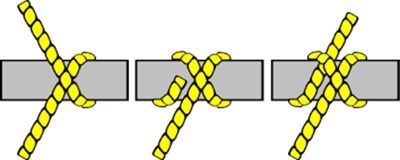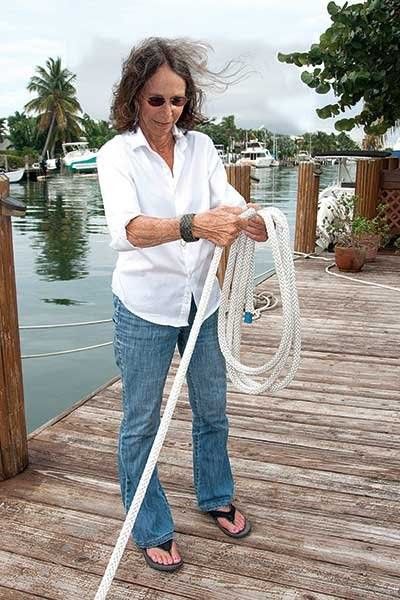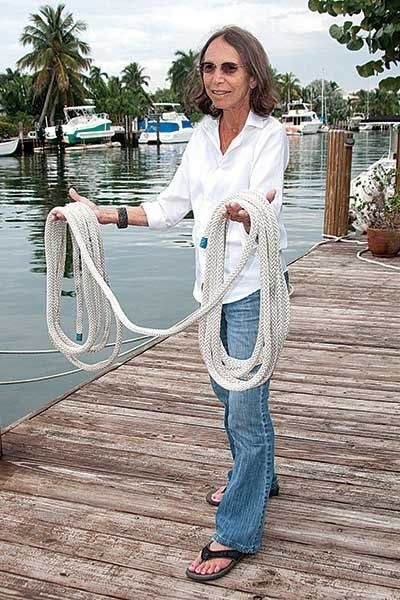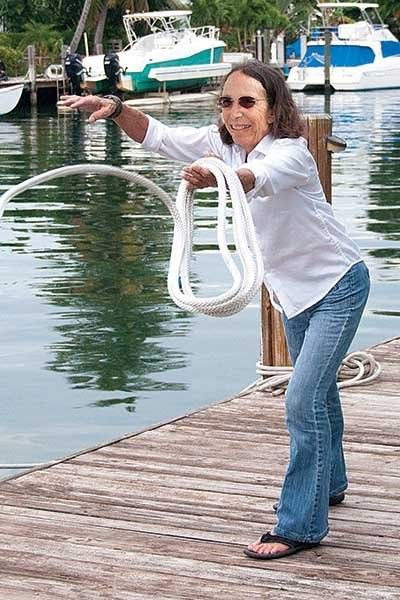Handling Lines
A few onboard line handling demonstrations and tips. I've put these in order of importance, so even if you're not comfortable sail handling; i.e., using a winch, you should be able to hang a fender using a clove hitch as this is done well in advance. And of course once you winch a sheet, you'll need to coil the rope. (Ropes aboard have names tied to their use, to avoid confusion. Any rope that controls a sail is known as a "sheet". Hence you may hear, "sheet in the main", meaning to bring the mainsail toward the centerline.) Finally, we may have to dock. It's always helpful to know the best way to cleat a line. Please try to practice these.
Fenders
You may have heard that the bowline ("Bohl in") is the most important knot. True, but for our purposes, the clove hitch is THE one to know if you only learn one. If you do nothing else, you will probably be asked to hang a fender (what landlubbers like to call "bumpers"), and a clove hitch is the way to make sure it's secure. It's brilliant in it's simplicity, and takes seconds when you learn it. This image is basic, but shows how easy it is to tie. Notice that the end result is two lines overlapped by one-- the same as when cleating a line. I also like this diagram as it shows the "X" pattern you want to achieve by crossing over the first line before going under itself:

For me it was seeing the "X", but you may learn better by seeing a video. Here's one using a slightly different technique to tie the same hitch:
Winches
Two videos. The first is only 77 seconds, but covers some important parts, including the winch handle. The second is a little more comprehensive (3 mins.) and emphasizes safety. I would disagree with them on the number of wraps. With the greater forces of a larger sailboat, use four:
Coiling Lines
This 3-minute video is the most comprehensive I've found, covering all the little techniques, and even shows another use of the clove hitch! My only addition is that's important to coil while sailing, for safety:
We will more likely anchor or pick up a mooring ball than dock. This video oversimplifies it a bit, but does show the proper way to importantly "bridle" a catamaran.
Cleats
Many people feel they already know how to cleat a line, and there are many 'accepted' methods. This is the most accepted, and works best for our sails because it's quick, easy to verify, will not get jammed, and allows room for another line to be cleated in crowded marinas. Please learn it:
Another approach and mnemonic that may be helpful, from ASA:
When you're coming alongside the dock, make sure the crew keeps clear and stays on the boat.
To avoid serious damage to stray body parts, make sure that fenders are the only things that ever come between your boat and the dock. Heroic leaps, dockline in hand, may provide comic relief if all goes well, but they can also result in serious injury. All crew members should learn to accurately heave a line to someone on the dock and practice this skill until it becomes second nature.
Here's what it looks like when a crew is unprepared to dock:
(too fast, fenders too high, no lines ready to toss! The sitting woman has it right-- don't panic, and pick up after yourself.)
Tossing a Line
Another useful but rarely learned skill is tossing a line to someone on the dock helping.
This instructor put together a series of helpful photos with instructions:
How To Throw A Line ... Properly!
By Pam Wall
It's all in the preparation. To toss a line accurately, and have it arrive at its destination, follow these four simple steps.
How cool would it be to throw a line ashore, to another boat, or to someone who has fallen overboard and always have it land where you want it to land? It's easier than you think. Here are some simple steps to follow for throwing a line and having it reach what you're aiming for.

1. Coil, Twist, Repeat
Coil the line in a clockwise direction using your fingers to give each coil a slight twist clockwise. Make sure that each of the coils is not too long, about 15 inches, and not twisted.

2. Divide And Conquer
Carefully take half the neatly coiled line in your left hand (if right handed) and the remainder in your tossing hand. Make sure the coils can flow out of your hands in sequence as you toss the line. Left-handed sailors will still coil the line clockwise, but the throwing hand will be the left hand and the second half of the line will be in their right hand.
TIP: Smaller coils are easier to throw. Start by making large coils. Then, halfway through, make the coils you'll be moving to the "throwing" hand slightly smaller.

3. Look Before You, Um, Throw
Using your left hand facing forward with half the coil and your right hand with the other half of the line to throw, look at what you are aiming for!

4. Let It Fly
Using a strong swing with your right hand, if that’s your throwing hand, throw the line underhand to where you are looking and let it fly out of your right hand and then out of the left hand with the remaining line following what has been tossed.
If your right-handed toss is strong enough, the coils in both hands can flow out of your hands easily (sometimes too easily — you may want to tie off the bitter end), provided the lines aren't twisted and, most importantly, your eyes remain on target. I guarantee you will always make the mark.
A couple of addenda. Not "may"-- DO cleat off the bitter end before tossing, and make sure the line is outside the lifelines (remind me to show you). Also, aim over the shoulder of the person to whom you're tossing. You want it to go past them (most beginners toss short), but you also don't want to hit them in the face with a wet rope. Other beginner mistakes: tossing too early (we'll get close, slowly), and not accounting for wind. A line falling short is now a danger to the propellor or bowthruster, and wet!
Capt'n Ed
P.S. I thought you might appreciate this photo of the famous instructor above as a young woman. She spent six years sailing around the world with two young children on a 39' sloop.
(I would need a bigger boat):

